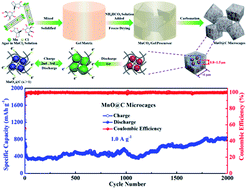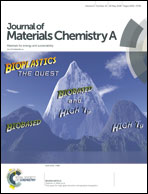High performance MnO@C microcages with a hierarchical structure and tunable carbon shell for efficient and durable lithium storage†
Abstract
A MnO@C microcage with a multi-structure and tunable carbon shell was fabricated through a facile bio-inspired synthesis strategy for highly reversible Li storage. Micrometer-sized MnO unit aggregates were covered with a porous carbon shell outside with a thickness of about 0.2 μm, and a graphene-analogous carbon network inside the MnO@C microcages. The carbon shell could be tunable by a graphene-base shell. The unique double-carbon-coating structure of the MnO@C microcages enabled realizing the high Li-storage performance of the MnO particles with a micrometer size. The electrode containing the MnO@C microcages delivered a high reversible capacity of 1450.5 mA h g−1 after 270 cycles at a current density of 0.1 A g−1, good rate capability, and outstanding cycling stability with a retention capacity of 805 mA h g−1 after 2000 cycles at a high current density of 1 A g−1. Quantitative kinetic analysis indicated that around 40% of the charge storage came from the capacitive contribution of the microcage structure. It was found that the tunable graphene-base shell could enhance the Li-ion diffusion rate significantly, and enable a stable ultralong long life cycle performance and enhanced rate performance of the microcages.



 Please wait while we load your content...
Please wait while we load your content...